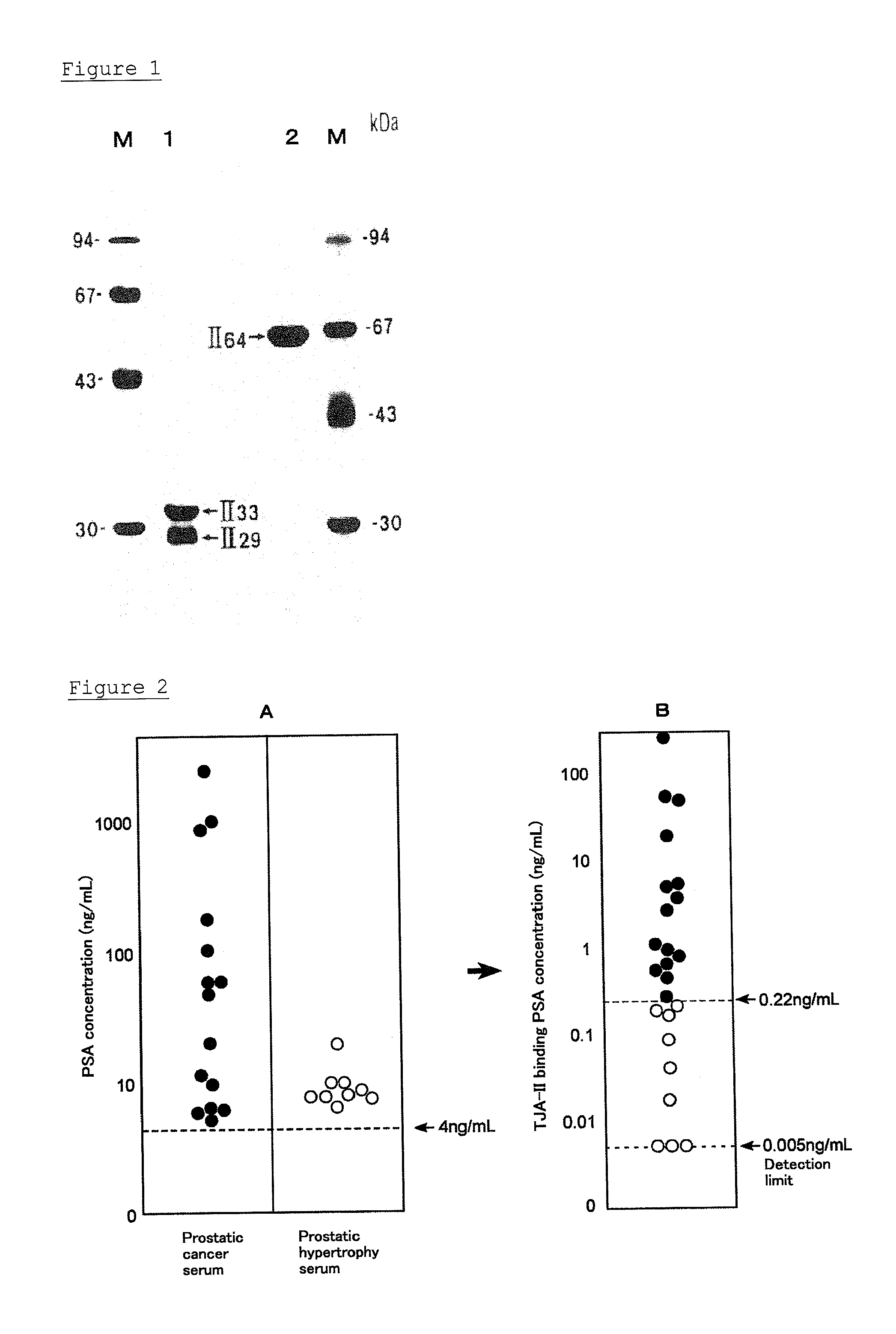Method for analyzing psa and method for distinguishing prostate cancer from prostatic hypertrophy using that method for analyzing psa
a prostate cancer and prostatic hypertrophy technology, applied in the field of analyzing psa, can solve the problems of excessive burden on patients, difficult to distinguish prostate cancer from prostatic hypertrophy,
- Summary
- Abstract
- Description
- Claims
- Application Information
AI Technical Summary
Benefits of technology
Problems solved by technology
Method used
Image
Examples
example 1
Analysis of PSA Using TJA-II
[0108]In this example, the amount of PSA was measured by the method for analyzing PSA of the present invention using the TJA-II column prepared in the example of column preparation, for 15 patients diagnosed as having prostate cancer and 9 patients diagnosed as having prostatic hypertrophy and having 4.0 ng / mL or more of total PSA.
[0109]The TJA-II column (1 mL volume) was equilibrated with PBS containing 0.1% bovine serum albumin (BSA) at 4° C. 1 μL to 50 μL of the serum sample was diluted with PBS to the volume of 200 μL, applied to the column, and held for 30 minutes. Then, the column was washed with 5-fold volume of a washing buffer (PBS containing 0.1% BSA), and fractionated to 1 mL for each, to obtain the TJA-II non-bound molecules. The column was stood at room temperature, and then fractionated to 1 mL for each and eluted with 5-fold volume of an eluting buffer (PBS containing 10 mM lactose and 0.1% BSA), to obtain the TJA-II bound molecules. The to...
example 2
[0112]In this example, the amount of PSA was measured by the method for analyzing PSA of the present invention for 3 patients diagnosed as having the prostate cancer using the WFA column prepared in the example of column preparation.
[0113]Specifically, the procedures of Example 1 were repeated except that the WFA column and an eluting buffer (PBS containing 10 mM GalNAc and 0.1% BSA) were used instead of the TJA-II column and the eluting solution (PBS containing 10 mM lactose and 0.1% BSA), and the serum samples of the 3 prostate cancer patients were analyzed, to obtain the amount of WFA-bound PSA and the WFA binding rate.
[0114]The results of the WFA binding rate are shown in Table 3.
[0115]Meanwhile, the WFA binding rate was calculated by the following equation.
WFA binding rate=(amount of PSA in the WFA binding fraction / total amount of PSA in the WFA non-binding fraction and in the WFA binding fraction)×100%
[0116]In addition, the TJA-II binding rates are shown in Table 3 for compari...
example 4
[0119]In this example, the binding rates of PSA to the TJA-II column, the UEA-I column and the WFA column were examined for PSA in the sera of the prostatic hypertrophy patients, PSA in the sera of the prostate cancer patients, and PSA in the seminal fluids of the normal person.
[0120]Measurement of the binding rate to the TJA-II column was performed in accordance with the method described in Example 1. Measurement of the binding rate to the WFA column was performed in accordance with the procedures described in Example 2.
[0121]In addition, measurement of the binding rate to the UEA-I column was performed as described below. The amount of UEA-I-bound PSA was measured using agarose immobilized with Ulex europaeus agglutinin-1 (UEA-I) (UEA-I agarose: J-oil mills). Specifically, the procedures of Example 1 were repeated except that UEA-I agarose and an eluting buffer (PBS containing 50 mM fucose and 0.1% BSA) were used instead of the TJA-II column and the eluting solution (PBS containin...
PUM
| Property | Measurement | Unit |
|---|---|---|
| Fraction | aaaaa | aaaaa |
| Fraction | aaaaa | aaaaa |
| Fraction | aaaaa | aaaaa |
Abstract
Description
Claims
Application Information
 Login to View More
Login to View More - R&D
- Intellectual Property
- Life Sciences
- Materials
- Tech Scout
- Unparalleled Data Quality
- Higher Quality Content
- 60% Fewer Hallucinations
Browse by: Latest US Patents, China's latest patents, Technical Efficacy Thesaurus, Application Domain, Technology Topic, Popular Technical Reports.
© 2025 PatSnap. All rights reserved.Legal|Privacy policy|Modern Slavery Act Transparency Statement|Sitemap|About US| Contact US: help@patsnap.com


